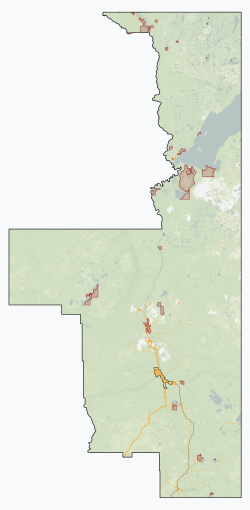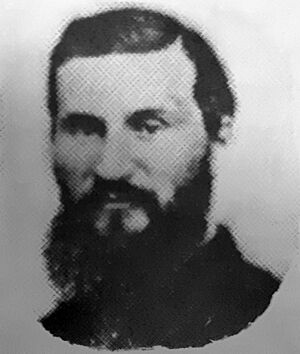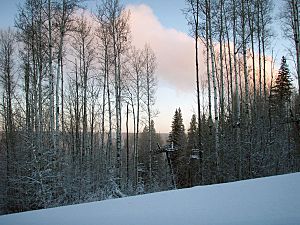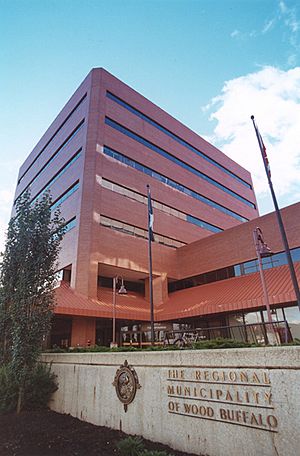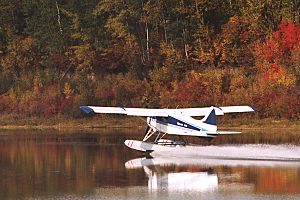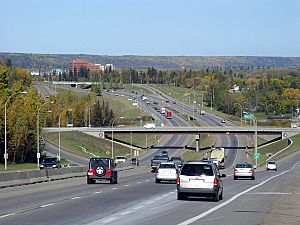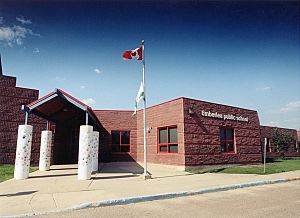Fort McMurray facts for kids
Quick facts for kids
Fort McMurray
McMurray (1947–1962)
|
|
|---|---|
| Fort McMurray Urban Service Area | |
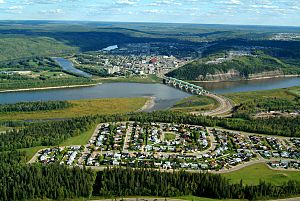
Aerial view of Fort McMurray with Athabasca River
|
|
| Nicknames:
"Fort Mac", "Fort McMoney"
|
|
| Motto(s):
We Have The Energy
|
|
| Country | Canada |
| Province | Alberta |
| Region | Northern Alberta |
| Census division | 16 |
| Specialized municipality | RM of Wood Buffalo |
| Founded | 1870 |
| Incorporated | |
| • Village | May 6, 1947 |
| • Town | December 29, 1948 |
| • New town | June 30, 1964 |
| • City | September 1, 1980 |
| Name changed | June 1, 1962 |
| Amalgamated | April 1, 1995 |
| Area
(2021)
|
|
| • Urban | 52.17 km2 (20.14 sq mi) |
| Elevation | 260 m (850 ft) |
| Population
(2021)
|
|
| • Urban | 68,002 |
| • Urban density | 1,303.5/km2 (3,376/sq mi) |
| • Municipal census (2021) | 72,917 |
| See Demographics section for population counts from RM of Wood Buffalo's recent municipal censuses. | |
| Demonym(s) | Fort McMurrayites |
| Time zone | UTC−07:00 (MST) |
| • Summer (DST) | UTC−06:00 (MDT) |
| Forward sortation areas |
T9H - T9K
|
| Area code(s) | 780, 587, 825, 368 |
| Highways | 63, 69 |
| Waterways | Athabasca River, Clearwater River, Hangingstone River, Horse River |
| Website | RM of Wood Buffalo |
Fort McMurray (pronounced mək-MURR-ee) is a community in Alberta, Canada. It's located in the northeast part of the province. This area is known for its large Athabasca oil sands deposits. The town is surrounded by thick boreal forest.
Fort McMurray has played a big part in Canada's oil industry. It was once a city. In 1995, it joined with a nearby area to form the Regional Municipality of Wood Buffalo. Even though it's now officially an "urban service area," many people still call it a city. Between 1947 and 1962, it was simply known as McMurray.
Contents
Discovering Fort McMurray's Past
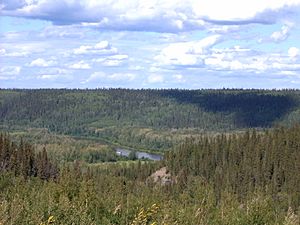
Before Europeans arrived, the Cree people lived in the Fort McMurray area. They knew about the Athabasca oil sands. They even used the natural tar from the ground to waterproof their canoes.
This area was an important meeting point during the North American fur trade. It was a key stop on the route from eastern Canada to the Athabasca region.
Early European Explorers
In 1778, Peter Pond was the first European explorer to visit. He was looking for furs, which were in high demand in Europe. Pond explored the Athabasca and Clearwater Rivers. He set up a trading post further north, but it closed in 1788.
In 1790, Alexander MacKenzie was the first to write about the oil sands. By this time, the Cree and explorers were already trading where the Clearwater and Athabasca rivers meet.
Founding the Trading Post
The Hudson's Bay Company set up a trading post here in 1870. It was named Fort McMurray after Chief Factor William McMurray. The post became a busy stop for travelers.
In 1915, the Alberta and Great Waterways Railway reached the area. This made travel and trade even easier, along with existing steamboat services.
Oil Sands Development
Fort McMurray has been very important to Canada's oil industry. People started looking for oil here in the early 1900s. But the town stayed small, with only a few hundred residents.
By 1921, there was serious interest in separating oil from the sands. The Alcan Oil Company was one of the first to test this. The nearby community of Waterways was created as a southern end point for water transport.
Abasands Oil was the first company to successfully get oil from the sands in the 1930s. They used a hot water method. Production was small at first. During World War II, Fort McMurray became a base for the Canol Project.
Growth and Change
In 1947, Fort McMurray and Waterways joined together. They became the village of McMurray. The "Fort" was added back to the name in 1962. It became a town a year later.
In 1967, the Great Canadian Oil Sands (now Suncor) plant opened. This caused Fort McMurray to grow very quickly. More oil sands plants opened, especially after the oil crises in the 1970s. The town's population jumped from 6,847 in 1971 to 31,000 by 1981. It became a city in 1980.
The population reached nearly 37,000 in 1985. But it dropped after 1986 because oil prices fell. Extracting oil from the oil sands is expensive. Lower prices made it less profitable.
Becoming an Urban Service Area
On April 1, 1995, Fort McMurray joined with Improvement District No. 143. This created the Municipality of Wood Buffalo. Later, it was renamed the Regional Municipality (RM) of Wood Buffalo. Fort McMurray was no longer officially a city. It became an "urban service area" within this larger municipality.
The RM's main office is in Fort McMurray. Most of the RM's residents live in the Fort McMurray urban area.
Oil prices rose again after 2003, making oil extraction profitable. This led to more growth. However, another drop in oil prices in 2014 and 2015 caused job losses.
In June 2013, heavy rains caused the Hangingstone River to flood. This led to a six-day emergency. Highways were closed, and 150 people had to leave their homes.
Major Wildfires and Floods
2016 Wildfire
On May 3, 2016, a huge wildfire started southwest of Fort McMurray. Everyone in the community had to leave. Very hot temperatures, low humidity, and strong winds made the fire spread fast.
More than 88,000 people were evacuated. This was Canada's largest wildfire evacuation ever. About one-fifth of the homes in Fort McMurray were destroyed.
2020 Flood
On April 27, 2020, large ice jams on the Athabasca River caused a major flood. Downtown Fort McMurray was badly hit. Streets were underwater, and many businesses, cars, and homes were damaged. About 13,000 people had to evacuate.
2024 Wildfire
On May 14, 2024, another wildfire caused some neighborhoods to be evacuated. Over 6,000 people had to leave their homes.
Fort McMurray's Location and Environment
Fort McMurray is about 435 kilometers (270 miles) northeast of Edmonton. It's near the Saskatchewan border. The community is nestled in the boreal forest. It sits where the Athabasca River, Clearwater River, Hangingstone River, and Horse River meet.
The elevation of Fort McMurray is 260 meters (850 feet) above sea level. It is the largest community in the Regional Municipality of Wood Buffalo.
Local Trees and Plants
Common trees in the area include white spruce, trembling aspen, balsam poplar, and white birch. In wet areas, you might see black spruce and tamarack. Jack pine grows in very dry spots.
Climate and Weather
Fort McMurray has cold winters, but sometimes warm chinook winds bring relief. Summers are mild to warm. Only three months of the year have an average temperature above 10°C (50°F). This means it has a subarctic climate.
The community is at a lower elevation than much of Alberta. This can make it a "hot spot" for temperatures.
Temperatures average -17.2°C (1.0°F) in January and 17.3°C (63.1°F) in July. The area gets about 404.6 mm (15.93 inches) of rain each year, mostly in summer. It also gets about 110.6 cm (43.5 inches) of snow, mainly from October to April.
The hottest temperature ever recorded was 40.3°C (104.5°F) on June 30, 2021. The coldest was -53.3°C (-63.9°F) on February 1, 1917, and December 31, 1933.
| Climate data for Fort McMurray (Fort McMurray International Airport) Climate ID: 3062693; coordinates 56°39′N 111°13′W / 56.650°N 111.217°W; elevation: 369.1 m (1,211 ft); 1991−2020 normals, extremes 1908−present |
|||||||||||||
|---|---|---|---|---|---|---|---|---|---|---|---|---|---|
| Month | Jan | Feb | Mar | Apr | May | Jun | Jul | Aug | Sep | Oct | Nov | Dec | Year |
| Record high humidex | 14.6 | 13.4 | 19.8 | 30.4 | 35.6 | 38.3 | 45.6 | 40.5 | 33.7 | 28.4 | 15.5 | 10.4 | 45.6 |
| Record high °C (°F) | 15.1 (59.2) |
16.1 (61.0) |
20.1 (68.2) |
35.0 (95.0) |
36.7 (98.1) |
40.3 (104.5) |
38.9 (102.0) |
37.0 (98.6) |
32.4 (90.3) |
29.4 (84.9) |
18.9 (66.0) |
10.7 (51.3) |
40.3 (104.5) |
| Mean daily maximum °C (°F) | −11.9 (10.6) |
−7.3 (18.9) |
0.1 (32.2) |
9.3 (48.7) |
17.2 (63.0) |
21.7 (71.1) |
23.9 (75.0) |
22.2 (72.0) |
16.2 (61.2) |
7.3 (45.1) |
−3.2 (26.2) |
−9.9 (14.2) |
7.1 (44.8) |
| Daily mean °C (°F) | −17.2 (1.0) |
−13.6 (7.5) |
−6.7 (19.9) |
2.7 (36.9) |
9.9 (49.8) |
14.9 (58.8) |
17.3 (63.1) |
15.6 (60.1) |
9.9 (49.8) |
2.4 (36.3) |
−7.6 (18.3) |
−14.8 (5.4) |
1.1 (34.0) |
| Mean daily minimum °C (°F) | −22.3 (−8.1) |
−19.9 (−3.8) |
−13.5 (7.7) |
−3.9 (25.0) |
2.6 (36.7) |
8.0 (46.4) |
10.6 (51.1) |
8.8 (47.8) |
3.5 (38.3) |
−2.5 (27.5) |
−11.9 (10.6) |
−19.6 (−3.3) |
−5.0 (23.0) |
| Record low °C (°F) | −51.7 (−61.1) |
−53.3 (−63.9) |
−44.4 (−47.9) |
−34.4 (−29.9) |
−17.3 (0.9) |
−6.1 (21.0) |
−3.3 (26.1) |
−6.1 (21.0) |
−15.6 (3.9) |
−24.5 (−12.1) |
−41.7 (−43.1) |
−53.3 (−63.9) |
−53.3 (−63.9) |
| Record low wind chill | −58.4 | −59.6 | −56.8 | −45.8 | −21.0 | −7.2 | 0.0 | −6.1 | −16.0 | −31.7 | −50.1 | −53.2 | −59.6 |
| Average precipitation mm (inches) | 15.7 (0.62) |
13.0 (0.51) |
15.3 (0.60) |
18.1 (0.71) |
31.0 (1.22) |
78.0 (3.07) |
77.4 (3.05) |
55.9 (2.20) |
43.7 (1.72) |
25.8 (1.02) |
17.2 (0.68) |
13.4 (0.53) |
404.6 (15.93) |
| Average rainfall mm (inches) | 0.2 (0.01) |
0.3 (0.01) |
2.3 (0.09) |
12.1 (0.48) |
30.8 (1.21) |
77.9 (3.07) |
80.0 (3.15) |
56.7 (2.23) |
43.1 (1.70) |
11.4 (0.45) |
1.8 (0.07) |
0.2 (0.01) |
316.7 (12.47) |
| Average snowfall cm (inches) | 20.3 (8.0) |
18.9 (7.4) |
17.1 (6.7) |
7.2 (2.8) |
2.5 (1.0) |
0.0 (0.0) |
0.0 (0.0) |
0.0 (0.0) |
1.4 (0.6) |
8.3 (3.3) |
18.3 (7.2) |
16.6 (6.5) |
110.6 (43.5) |
| Average precipitation days (≥ 0.2 mm) | 13.3 | 11.3 | 10.7 | 9.5 | 11.2 | 16.0 | 17.1 | 13.6 | 13.2 | 11.0 | 12.5 | 12.0 | 151.4 |
| Average rainy days (≥ 0.2 mm) | 0.4 | 0.3 | 1.7 | 6.3 | 10.7 | 14.5 | 16.7 | 13.8 | 13.6 | 6.0 | 1.7 | 0.7 | 86.1 |
| Average snowy days (≥ 0.2 cm) | 12.5 | 10.9 | 9.7 | 3.7 | 1.2 | 0.0 | 0.0 | 0.0 | 0.6 | 5.6 | 11.2 | 11.5 | 66.7 |
| Average relative humidity (%) (at 1500 LST) | 69.9 | 60.9 | 49.0 | 40.5 | 37.3 | 46.0 | 49.8 | 49.6 | 51.8 | 58.9 | 71.6 | 74.3 | 55.0 |
| Mean monthly sunshine hours | 77.7 | 113.8 | 176.0 | 217.3 | 276.5 | 264.5 | 285.5 | 265.8 | 165.2 | 118.4 | 63.2 | 65.2 | 2,088.9 |
| Percent possible sunshine | 33.2 | 42.5 | 48.1 | 50.9 | 54.4 | 49.9 | 53.9 | 56.5 | 42.9 | 36.6 | 25.6 | 30.3 | 43.7 |
| Source: Environment and Climate Change Canada (sun 1981–2010) | |||||||||||||
Neighborhoods
Fort McMurray has many neighborhoods. Some of them are Abasand Heights, Beacon Hill, Dickinsfield, Eagle Ridge, Grayling Terrace, Gregoire, Lower Townsite, Parsons Creek, Prairie Creek, Saline Creek, Stone Creek, Thickwood Heights, Timberlea, and Waterways.
Population and People
| Federal census population history |
||
|---|---|---|
| Year | Pop. | ±% |
| 1951 | 926 | — |
| 1956 | 1,110 | +19.9% |
| 1961 | 1,186 | +6.8% |
| 1966 | 2,614 | +120.4% |
| 1971 | 6,847 | +161.9% |
| 1976 | 15,424 | +125.3% |
| 1981 | 31,000 | +101.0% |
| 1986 | 34,949 | +12.7% |
| 1991 | 34,706 | −0.7% |
| 1996 | 33,078 | −4.7% |
| 2001 | 38,667 | +16.9% |
| 2006 | 47,705 | +23.4% |
| 2011 | 61,374 | +28.7% |
| 2016 | 66,573 | +8.5% |
| 2021 | 68,002 | +2.1% |
| Source: Statistics Canada |
||
Population Counts
In the 2021 Canadian census, Fort McMurray had 68,002 residents. This was a small increase from 2016. The area covers about 52.17 square kilometers (20.14 sq mi).
The RM of Wood Buffalo's 2021 local census counted 72,917 permanent residents. This number also includes a "shadow population" of 3,089 non-permanent residents. These are often workers who live in temporary camps.
Diverse Community
Fort McMurray is becoming a very multicultural place. The 2021 census showed that about 6,700 people moved to the region since 2018.
Many new residents come from other parts of Canada. Most come from Alberta (55%). Others come from Newfoundland and Labrador (13%), British Columbia, and Ontario.
Ethnic Backgrounds
The 2021 census found that 61.5% of residents are white. About 10% identify as Indigenous. Other large groups include Southeast Asian (9.2%) and South Asian (7%).
Indigenous peoples make up about 7% of the population. This includes First Nations people (4%) and Métis people (2.89%).
Fort McMurray is home to people from many different backgrounds. This makes it a vibrant and diverse community.
Fort McMurray's Economy
Fort McMurray is a major center for petroleum production in Canada. It's located right in the middle of the Athabasca oil sands.
Besides oil, the economy also relies on natural gas, pipeline transport, forestry, and tourism. Big oil sands companies like Syncrude and Suncor Energy operate here.
Fort McMurray's growth is like a "boomtown." This means it grows very quickly when the oil industry is doing well. Because of this, housing prices and rents can be much higher here than in other remote areas.
Community Infrastructure
Air Travel
The Fort McMurray International Airport is the largest airport in northern Alberta. It has scheduled flights to major cities like Calgary, Edmonton, and Toronto. Many oil companies also use the airport for corporate and charter flights. These flights take workers to private airstrips at oil sands sites.
Public Transportation
Fort McMurray Transit provides bus service within the community. Its routes cover all neighborhoods in Fort McMurray. The service also goes to smaller communities in the RM, like Anzac and Conklin.
Intercity bus services like Ebus and Red Arrow connect Fort McMurray to Edmonton. They also serve other communities along Highway 63.
Roads and Highways
Highway 63 is the main road connecting Fort McMurray to Edmonton. Because of the oil sands industry, this highway carries a lot of heavy loads. It was fully widened to two lanes in each direction in May 2016. Highway 881 also provides another way to reach the region.
Mail Service
In 2014, Canada Post considered adding a special fee for packages sent to Fort McMurray. They said it was expensive to deliver mail there. However, they decided not to add the fee.
Education and Learning
Both the Fort McMurray Public School District (FMPSD) and the Catholic School District serve students in Fort McMurray. They offer different programs, like French immersion and performing arts. Only FMPSD offers the Advanced Placement program at Westwood Community High School.
École Boréal is the only French-speaking school in the area. It teaches students from pre-kindergarten to grade 12.
Keyano College is a public college in Fort McMurray. It helps train workers for the oil sands industry. Keyano College also has a modern theatre and recital hall. These venues host many musical and theatrical events.
Sports and Fun Activities
Fort McMurray has several sports teams. These include:
- The Fort McMurray Oil Barons (junior hockey team)
- The Fort McMurray Giants (baseball team)
- The Keyano Huskies (college sports teams)
MacDonald Island Park is a large recreation center. It's located northeast of downtown. This center has:
- The Wood Buffalo Regional Library
- An indoor water park
- Courts for basketball, tennis, and squash
- A rock climbing wall
- A fitness center
- An indoor playground
- Ice rinks
- Spaces for public events
Shell Place is a connected sports facility. A seasonal golf course surrounds the center. The Fort McMurray Knights Rugby Football Club is also based in the town.
Famous People from Fort McMurray
- Tantoo Cardinal, actress
- Mikael Colville-Andersen, urban designer
- Mark Hartigan, professional hockey player
- Natasha Henstridge, actress
- Aaron Lines, musician
- Cassandra Naud, actress and dancer
- Kudakwashe Rutendo, actress
- Daniel Sunderland, Olympic bobsleigher
- Brooke Voigt, Olympic snowboarder
- Massey Whiteknife, business executive and musician
- Chris Phillips, professional hockey player
- Carter Yakemchuk (born 2005), ice hockey player, picked 7th overall in 2024 NHL draft by Ottawa Senators




